#Meta Description:
Explore tagged Tumblr posts
Text
https://paintingdrive.com/blog/work-with-the-best-painting-company-in-mumbai/
#MumbaiHomes#InteriorMakeover#WallPainting#MumbaiLifestyle#DecorGoals#5. Title:#Your Trusted Painting Company in Mumbai – Hassle-Free Services#Meta Description:#We are Mumbai's trusted painting experts. From wood finishes to textured walls#your dream interiors are just a call away.#Hashtags:#MumbaiPaintingCompany#HomeRevamp#QualityFinishes#6. Title:#Luxury Painting Solutions in Mumbai – Redefine Your Space#Elevate your home with luxury painting services in Mumbai. From smooth coatings to high-end textures#we’ve got it all.#LuxuryPainting#MumbaiInteriors#ElegantWalls#7. Title:#Best Painting Contractor in Mumbai – A New Look for Your Space#Hire the top painting contractors in Mumbai for flawless finishes. Get a free consultation today.#PaintingContractors#MumbaiServices#HomeStyling#8. Title:#Mumbai’s Favorite Painting Experts – Your Walls#Our Art
1 note
·
View note
Text
Unlocking the Power of Mobile Application Development for Your Business
In the modern digital age, having a mobile presence is no longer optional—it's essential. As businesses strive to stay competitive and connected with their customers, mobile application development emerges as a powerful tool to achieve these goals. At OnePixelsoft, we specialize in crafting custom mobile applications that cater to the unique needs of businesses, driving growth and enhancing customer engagement. Here’s how mobile application development can transform your business.
1. Enhancing Customer Engagement
Mobile apps provide a direct and personalized channel to engage with your customers. By leveraging push notifications, personalized content, and in-app messaging, you can keep your audience informed and engaged. This direct line of communication helps build stronger relationships with your customers, leading to increased loyalty and higher conversion rates.
2. Improving Accessibility
In our fast-paced society, customers value the convenience of accessing services and products on the go. A mobile app ensures your business is always within reach, providing a seamless user experience. Whether it's making a purchase, booking a service, or seeking support, a mobile app makes it easier for customers to interact with your business anytime, anywhere.
3. Elevating Customer Service
A mobile app can significantly improve your customer service capabilities. By integrating features such as live chat, FAQs, and support tickets, you can provide quick and efficient assistance to your customers. Offering instant solutions to queries and issues boosts customer satisfaction and builds a reputation for excellent service.
4. Creating New Revenue Streams
Mobile apps open up new avenues for generating revenue. You can monetize your app through in-app purchases, subscription models, and targeted advertising. Additionally, a well-designed app enhances your e-commerce capabilities, providing a smooth and enjoyable shopping experience that encourages more spending.
5. Gaining a Competitive Edge
In a crowded market, a mobile app can set your business apart from the competition. It demonstrates your commitment to innovation and customer satisfaction. Moreover, a mobile app provides valuable insights into user behavior, helping you tailor your marketing strategies and product offerings to better meet customer needs.
6. Driving Digital Transformation
Mobile application development is a crucial component of digital transformation. By integrating a mobile app into your business strategy, you can streamline operations, improve communication, and increase overall efficiency. This leads to significant cost savings and better resource management, positioning your business for long-term success.
Why Choose OnePixelsoft?
At OnePixelsoft, we understand that every business is unique. That's why we offer customized mobile application development services tailored to your specific requirements. Our team of experienced developers works closely with you to understand your goals and create a mobile app that not only meets but exceeds your expectations.
Our Expertise:
Mobile Application Development: Cutting-edge mobile apps that enhance user experience and drive business growth.
Digital Transformation Solutions: Comprehensive solutions to help your business thrive in the digital age.
IT Consultancy Services: Expert advice to optimize your technology infrastructure and strategy.
Graphic Design Services: Stunning visuals that captivate and engage your audience.
WordPress Website Development: Robust and scalable websites that boost your online presence.
Transform Your Business Today
In conclusion, mobile application development can profoundly impact your business by improving customer engagement, increasing accessibility, and unlocking new revenue streams. At OnePixelsoft, we are dedicated to helping you achieve your digital transformation goals through innovative and effective solutions. Contact us today to learn how our mobile application development services can revolutionize your business.
Connect with Us:
Website: www.onepixelsoft.com
Instagram: @onepixel_soft
Google Maps: OnePixelsoft Location
Call Us: +91 77374 51230
Let’s make 2024 your most successful year yet with cutting-edge mobile application development!
#Mobile Application Development#Mobile App Development#Business Transformation#Customer Engagement#Digital Transformation Solutions#Mobile Application Development Services#Mobile App Benefits#Business Growth#IT Consultancy Services#Software Development Company#Meta Description:
0 notes
Text
Mulch Products Winnipeg | Manitoba’s Concrete Products

#Mulch Products Winnipeg | Manitoba’s Concrete Products | Garden Items#Winnipeg | Winnipeg Business Supplies | Landscape and Aggregates In winnipeg#| Thrifty Winnipeg#Meta Description:#We are your one-stop shopping destination. The Canadian retail industry is#undergoing a revolution thanks to online shopping. Our store uses the latest#shopping technology to provide a unique shopping experience. Nearly everything#you buy from us is at the lowest possible#keywords:#Landscaping supply winnipeg#Decorative stones winnipeg#Granular Stone Winnipeg#Topsoil winnipeg
0 notes
Text

"[Dick Grayson is] just this incredibly positive, pure force of good, and I wanted to show that to the world as well." — Tom Taylor

"Nightwing is…incredibly vital to the whole DCU and adaptable. He knows everyone. He’s served as a follower, and he’s served as a leader. He has connections to the Teen Titans and the Titans and the Justice League and the Bat-group… So, he’s facing the dark web, but he’s at the center of his own web." — Benjamin Percy

"In many ways, even more than Superman or Batman, Nightwing is the soul, the linchpin, of the DCU. He's well-respected by everyone, known to the JLA, the Titans, the Outsiders, Birds of Prey—everyone looks to him for advice, for friendship, for his skills. He's the natural leader of the DCU." — Phil Jimenez


"No matter how much he’s tempted to the dark, to vengeance, he always soars above." — Steve Orlando

"As Bruce's closest ally besides Alfred but somebody who Bruce probably pushes away more than any other person…Dick Grayson…is [Bruce’s] greatest tether to humanity. Dick's the person that would pull him back from the edge…Dick is an integral part of the Bat mythology and an endlessly interesting character." — Scott Snyder

"To me he's kind of the heart of DC Comics...he can be the heart and soul and carry the entire DC Universe." — Tom King
Dick Grayson: The Heart & The Soul
(according to his writers, his artists, and Bruce Wayne)
Panels: Batman/Catwoman: The Gotham War: Scorched Earth | Batman: Wayne Family Adventures (S3) Ep. 137 Compromise | Infinite Crisis #4 | Infinite Crisis #3 | Batman (2011) #11 | Titans (2016) #19 | Batman: Wayne Family Adventures (S3) Ep. 155 Trust
#I found this sitting in my drafts from a month ago#can't believe I never posted it#so I just had to stay up way too late add the image descriptions add another couple of quotes and so on#web weaving#I guess this is a web weave#maybe?#web weave#dc#batman#dc comics#dcu#batfamily#batfam#dick grayson#bruce wayne#tom king#scott snyder#phil jimenez#benjamin percy#tom taylor#meta
528 notes
·
View notes
Text
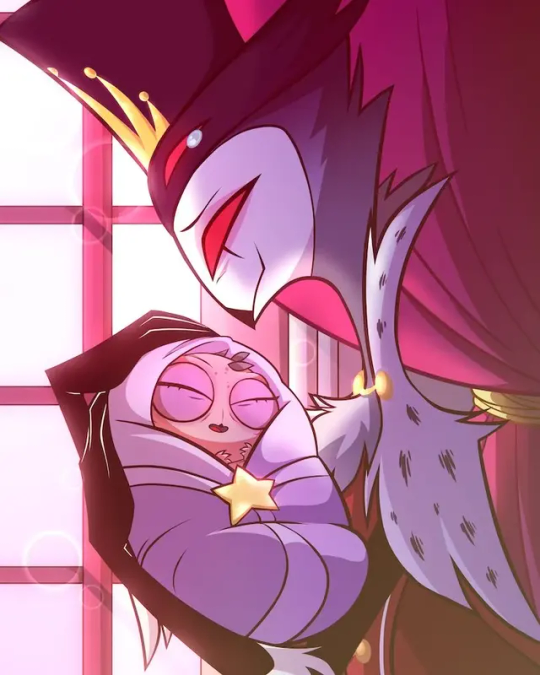

These two pictures absolutely kill me. Stolas is only 17, 18, or 19 in these photos. He is so, so fucking young to be having a baby. There are many parents who have kids at that age that deeply regret it, because raising a child is hard and severely limits your ability to go out and experience life the same way that your peers are. There are also many people who are forced into arranged marriages and pressured into having children as soon as possible that just cannot connect well with said children (Stella seems to fall into this category).
But not Stolas. He loves that little baby with his entire heart and soul. Even though he seems exhausted in that first picture (which, duh, she's a newborn, they're exhausting to take care of, especially for first time parents), he is holding her so tenderly and looks like he loves her so much he could cry. And in that second picture she is maybe 1 year old, and he looks like the happiest person alive. She is his everything. She is the tiny, adorable pocket of joy in his dark, painful, lonely world. She is the only thing that's even worth living for.
He loves her so, so fucking much, and it's completely baffling to me that anyone who isn't an emotionally compromised teenager could look at all of the photos he has with her and say that just because he has made a few mistakes lately and has split his attention to make room for someone else, that he's a bad, neglectful father. There is no one, not even Blitz, who could match the sheer depth of love he has for her. Blitz is his light, but Octavia means everything to him (to a previously kind of unhealthy, codependent degree actually, but that's a little beside the point and at least he's never tried to parentify her or make her play therapist for him despite that).
Just look at those pictures! Just look at them, and tell me honestly that he doesn't love her and thinks of her as solely an obligation. Octavia's feelings of abandonment and belief that he doesn't love her make sense, because she lacks a lot of the context that we have and her life got several major upheavals within the last two years, in addition to having preexisting abandonment issues that color her perception of the situation and a mother who was actively sabotaging his attempts to contact her for a month. But we, the audience, should see those pictures for what they are: a very young man who loves his child deeply, despite having never been demonstrably loved before; who is tender and playful with her, despite having never been shown that same tenderness or playfulness with anyone but debatably Blitz as a child. And the fact that she looks so happy as well is a very good indicator that he is the kind of loving, attentive, and secure parent she needed.
638 notes
·
View notes
Note
Stolas just standing there and letting blitz hug him in the end is all good, right? He is just sad because of octavia and accepting that blitz is there with him right?? It's not that he regrets chosing him, right??? (I just need affirmation)
You know what? I've found myself needing reassurance about this too. So let's take a moment to look at the facts together, shall we?
(This reply turned out way longer than I expected it to 😅 sorry!)
Fact #1 - Stolas is still coming to terms with the consequences of his actions. He spends the whole episode finding out just how much his life has changed. Learning how to navigate groceries, and laundry, and meals, and having a job, and worrying about money.
Mid-episode, he has a breakdown where he truly questions if everything he gave up was worth it just for a fantasy. At this point in the episode, he still hasn't realised how much he means to Blitz. As far as he's concerned, he did all of this for someone who doesn't reciprocate his feelings. By the end of the episode, though, his feelings have settled enough for him to express what he has known to be true all along: that saving Blitz was the right thing to do.
What Stolas regrets isn't saving Blitz's life, or even loving Blitz in the first place.
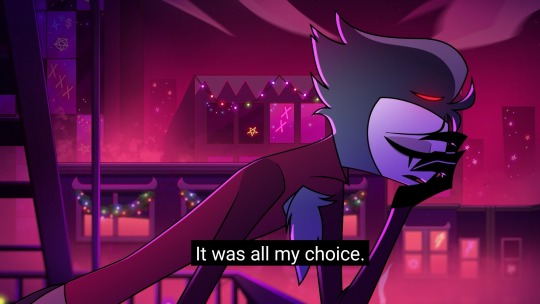
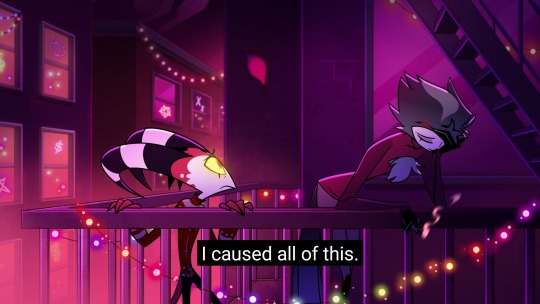
What he regrets are the choices he made that led them to this. He feels guilty for selfishly (or, rather, naively) playing out his fantasies. He's the one who established the deal, who let Blitz illegally use the book for many months, who wasn't always sensible about how he expressed his love for Blitz publicly and despite being married, and who allowed himself to ignore the reality of his situation so he could live in his own, personal romcom—all of which ultimately led to the events of Mastermind and the loss of Via.
And all the guilt and regret he's grappling with (however justified it might be) is exacerbated by fact #2, which is:
Fact #2 - Stolas is off his medication. He's been off it for a month now. Symptoms of depression (especially untreated depression) include mood swings, irritability, self-hatred and low self-esteem, passive/active suicidal ideation, pessimism and hopelessness about the future, catastrophising, black-and-white thinking, and anhedonia (inability to feel pleasure and to find joy in things—and people—who used to bring you it). All symptoms Stolas exhibits throughout this episode.
So, even if he shows a lack of emotion toward Blitz at times, or irritation to seemingly minor things like low doors or "secretating" or Karen's behaviour, even if he acts regretful and angry and desolate... a lot of these emotions and behaviours are a result of his depression, and not of actually hating the life he chose.
Fact #3 - Stolas loves Blitz. He always has, and always will. I could point at a thousand different moments in the show when Stolas' love for Blitz has transpired, but I'm going to leave it at his line from Mastermind: "I would rather be dead than live life without you by my side."
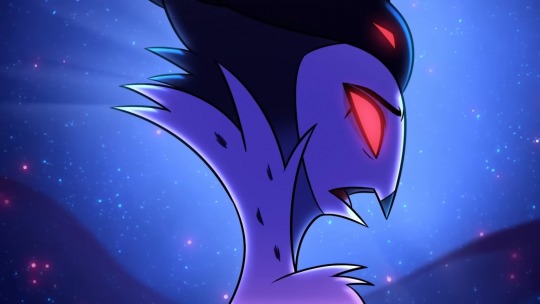
Even after everything they've gone through, even now that he's taken Blitz off his pedestal and can acknowledge that Blitz can be a fucking idiot... Stolas simply does not want to live a life without Blitz. It has always been Blitz. It will always be Blitz.
Stolas loves Blitz.
Fact #4 - Stolas kissed Blitz. Before he truly hits rock bottom as a result of Octavia cutting him out, Stolas is so ecstatic that Blitz cares, that Blitz was willing to go to such lengths to save his life, that he can't hold back the need to kiss Blitz mid-air. Suddenly, none of his earlier frustration matters. Nothing matters expect for how elated he is that Blitz loves him back. So he smiles and he pulls Blitz into a kiss because he can't bear not to kiss Blitz for a moment longer.
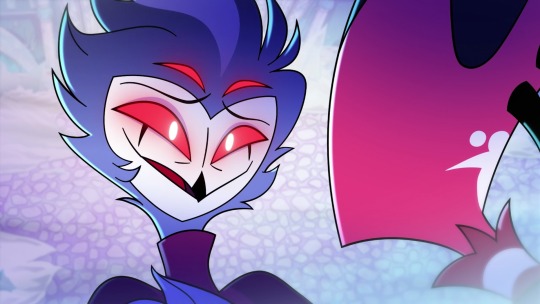
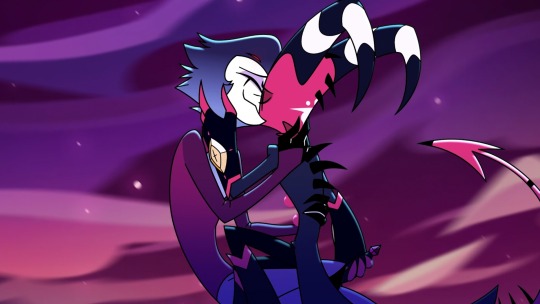
Look at this man. Look at how happy he is. Because it's always been Blitz, and maybe it was a fantasy for a long time, but it doesn't have to be anymore. Maybe this can be real now. He's so happy he (and I) could cry.
Fact #5 - Stolas didn't deny loving Blitz. When Via said "You don't love me, you love him," the script very purposefully did not have Stolas go "no, no, Via, that's not true—" or say anything else that might make Blitz doubt, even for a moment, that Stolas loves him. Because that much is true. He does love Blitz. He just also loves Via. Which brings me to:
Fact #6 - Blitz knows Stolas loves him. At no point throughout the episode does Blitz doubt, even for a second, that Stolas loves him. And we know this because Blitz's walls remain down at all times. If Blitz doubted he was loved, if he had even the slightest of reservations, those walls would come crawling back up whether he wanted them to or not. It's what he's been trained and conditioned to do—it's how he's kept his heart safe ever since the accident.
But now, he knows his heart is safe with Stolas. He believes it enough to not depend on his walls to feel at ease. He believes it enough to let himself take care of Stolas and be soft with Stolas without the slightest trace of hesitation.

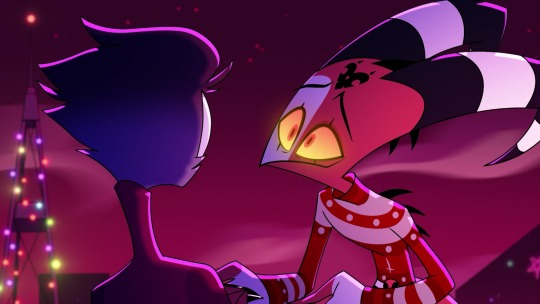

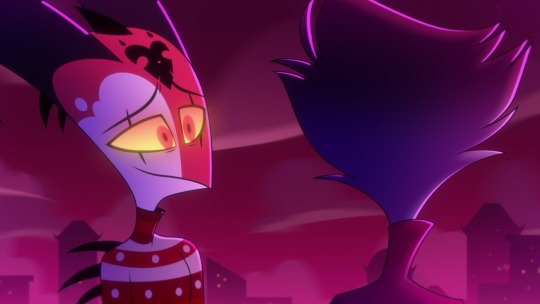
Look at Blitz's face. This is the face of a man who knows that even if Stolas isn't okay right now, things will get better. And when they do, they'll both still be in love with each other. This is the face of a man who can't wait for something beautiful to flourish between them, but who is in no rush to get there. He knows the road ahead is hard and painful, but he has faith in Stolas. In both of them.
Fact #6 - Stolas was happy to share a private, romantic dance with Blitz. Despite everything going through his mind, he found comfort and happiness in dancing with Blitz; in getting to have this little moment with him.
He found relief in the fact that Blitz stayed with him this time, even after Stolas told him, once again, that he didn't have to stay.
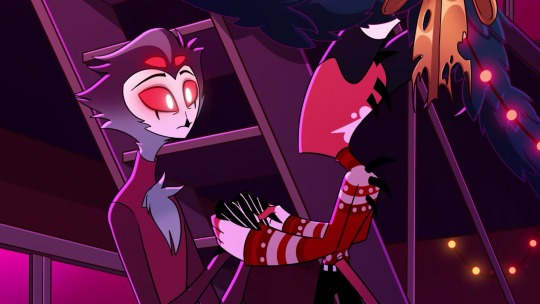

His reaction to Blitz initiating a dance between them is genuine surprise, immediately followed by an enamoured little smile at the mere notion that he gets to have this, now.
And, as they dance, he keeps smiling and leaning into Blitz, going as far as to manage a deep, heartfelt laugh at Blitz's words. This, for an unmedicated, depressed person going through one of the worst days of his life, is huge in itself. It shows that, even in the worst of times, he finds undeniable comfort and happiness in Blitz.
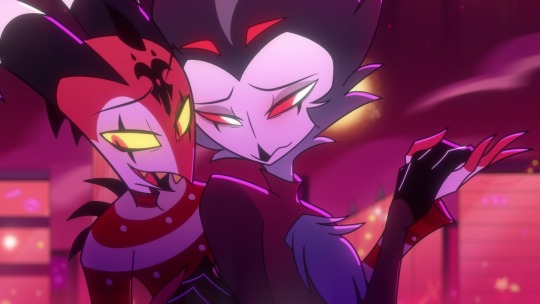
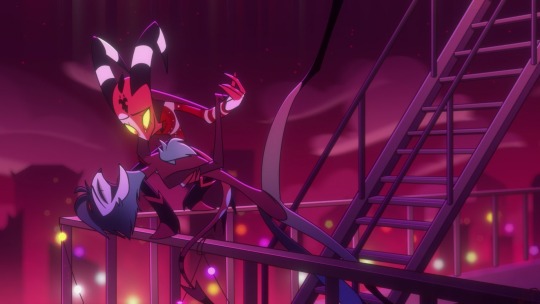
And, after their dance, Stolas looks at Blitz with a sobriety and soft sort of realisation that shows he's finally coming to terms with the fact that this is real. After everything he's lost, after all the fantasies he hoped for for so long and believed he'd never have, he finally gets to have this.
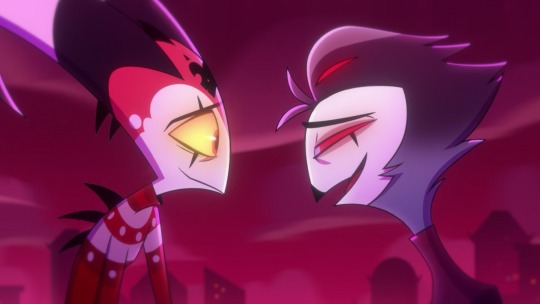

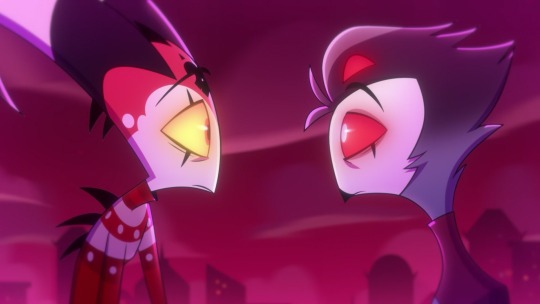
Despite the pain he's going through, Stolas looks at Blitz and sees the man he loves.
Notice how Blitz's eyes trail down to Stolas' mouth. And Stolas realises. And doesn't move away. Waiting, expectantly, for Blitz's next move, fully expecting it to be a kiss.
But then Blitz hugs him instead, and Stolas doesn't hug back.
And it's not because he doesn't want to be hugged by Blitz. It's not because his feelings for Blitz have changed, or dimmed, or disappeared. It's not because he regrets loving Blitz, or saving him. It's not because he doesn't want to have a close, healthy, loving romantic relationship with Blitz.
It's because of facts #1 (he's grappling with so much guilt and coming to terms with the consequences of his actions) and #2 (he's experiencing symptoms of unmedicated depression). And, above all, it's because of fact #7, which is...
Fact #7 - Stolas doesn't know how to be loved. Stolas has never had support. He has never had a shoulder to cry on, or someone to hold him when he needed it. When he's feeling vulnerable and broken, he defaults to hugging himself as a way to self-soothe, because that's the only comfort he's ever known.
And because he's never known comfort from others—because it was never allowed or safe for him to need or ask for comfort from others—all Stolas knows to do with his vulnerability is hide it. So much so that, the two times we see him begin to break down in front of Blitz before this episode, he either portals Blitz away or masks his tears and pain immediately. Even as he drunkenly rambles about wanting to be held, he still makes sure not to appear like he actually needs a hug.
So when he finds himself being held by Blitz in a warm, comforting hug, Stolas doesn't know how to respond. Because he's never had this. He's never had an opportunity to learn how to exist in someone's comforting embrace, how to interact with this kind of physical contact. He still has to learn how to feel safe between arms that aren't his own.
Simply put, Stolas still doesn't know how to hold Blitz back.
That doesn't mean Stolas doesn't want or need physical comfort. He needs it desperately—everyone does. But wanting something and knowing how to actually have it are two very different things, and Blitz knows that better than anyone, because he's wanted Stolas for a very long time, but didn't, until very recently, know how to feel safe accepting Stolas' love.
And that's why Blitz is completely understanding of the fact that all Stolas can do, all Stolas has the ability to do, is stand there and let himself be held, and let his emotions go through him. In, and out, with every breath, with every second. And get slowly acquainted with what being comforted by the person he loves feels like.
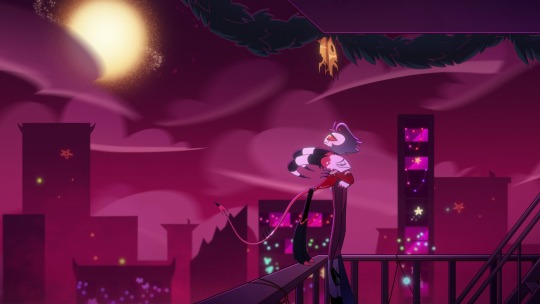
Thirty-something years of trauma can't be undone in a single hug, or a single conversation, and it's going to take time for Stolas to learn how to be present while in Blitz's arms, and how to return that emotional closeness.
But Blitz has faith in him. Blitz is willing to be patient and soft with him while he gets better. Blitz is ready to meet Stolas where he's at, because he knows, beyond a trace of doubt, that they love one another, and they're going to be okay. Even if Stolas doesn't know it yet—even if we, the audience don't know it yet—Blitz knows.
And that's just going to have to be enough for now.
And because this post got completely away from me, I shall conclude by quoting their song, because it summarises their story better than I ever could:
Truer love is hard to find. ❤️
#helluva boss sinsmas#helluva boss spoilers#helluva boss#stolitz#Long post#helluva boss meta#helluva boss stolas#helluva boss blitz#blitz helluva boss#stolas helluva boss#stolas goetia#Blitzo#image description in alt
512 notes
·
View notes
Text

“Are… they gonna be okay?” “Probably.”
(ID: Kirby series fanart comic of Shadow Kirby showing off his fighting skills to the Wave 2 gang, prompting rather… mixed reactions. Transcript in Alt Text. END ID.)
Started 11/23/24, finished 12/14/24.
#veins art#veins fanart#kirby series#kirby#shadow kirby#master kirby#adeleine#daroach#ribbon kirby#dark meta knight#wave 2#various kirby enemies#comic#description in Alt Text#bit of an overachiever when he puts his mind to it#even if he’s still holding back (at least in Dark’s opinion)#Daroach would’ve been impressed at the kid’s skills either way - he’s just not the biggest fan of needless violence#nor are the girls#Addie having very little stomach for conflict#and Ribbon only just growing used to the idea of the world being anything but bright and cheerful#(but that’s starting to veer into AU thoughts and this is meant to be gen canon so…)#also Dark brought the Energy Drink for himself - not SK#veinsfullofstars
467 notes
·
View notes
Text
yes, yes, boba fett finds it strange and uncomfortable when people can see his face and this is one of the major reasons he almost never removes his helmet (in the expanded universe anyway), but another factor that i think isn't explored nearly enough is just how much his helmet shapes how he sees the world. it grants him 360° vision, lets him interface with his weapon systems and slave I, and automatically dampens loud noises and dims bright lights. imagine going through the vast majority of your life seeing the world through that lens and then suddenly taking it away. removing his helmet for any significant length of time likely isn't just uncomfortable for him but downright disorienting.
#boba fett#boba fett meta#so much is made of how mandalorian helmets have all these powerful‚ often perception-altering features#and how many mandalorians spend the majority of their lives wearing them#i'm surprised there aren't more references to the difficulties such mandos might have adjusting to NOT wearing them#not just socially but like on a sensory level#there's one description in the boba fett junior novels that i really love#where bitty!boba gets his helmet knocked off his head by another bounty hunter#and the barrage of light and sound is compared to water being poured over his face#like it's that jarring to him#and that's when he was still a kid and hadn't yet experienced literal years of wearing his helmet every day!#so imagine what it's like for him when he's an adult making that transition#star wars#mandalorians
985 notes
·
View notes
Text
So I accidentally almost got into an argument on Twitter, and now I'm thinking about bad historical costuming tropes. Specifically, Action Hero Leather Pants.
See, I was light-heartedly pointing out the inaccuracies of the costumes in Black Sails, and someone came out of the woodwork to defend the show. The misunderstanding was that they thought I was dismissing the show just for its costumes, which I wasn't - I was simply pointing out that it can't entirely care about material history (meaning specifically physical objects/culture) if it treats its clothes like that.
But this person was slightly offended on behalf of their show - especially, quote, "And from a fan of OFMD, no less!" Which got me thinking - it's true! I can abide a lot more historical costuming inaccuracy from Our Flag than I can Black Sails or Vikings. And I don't think it's just because one has my blorbos in it. But really, when it comes down to it...
What is the difference between this and this?
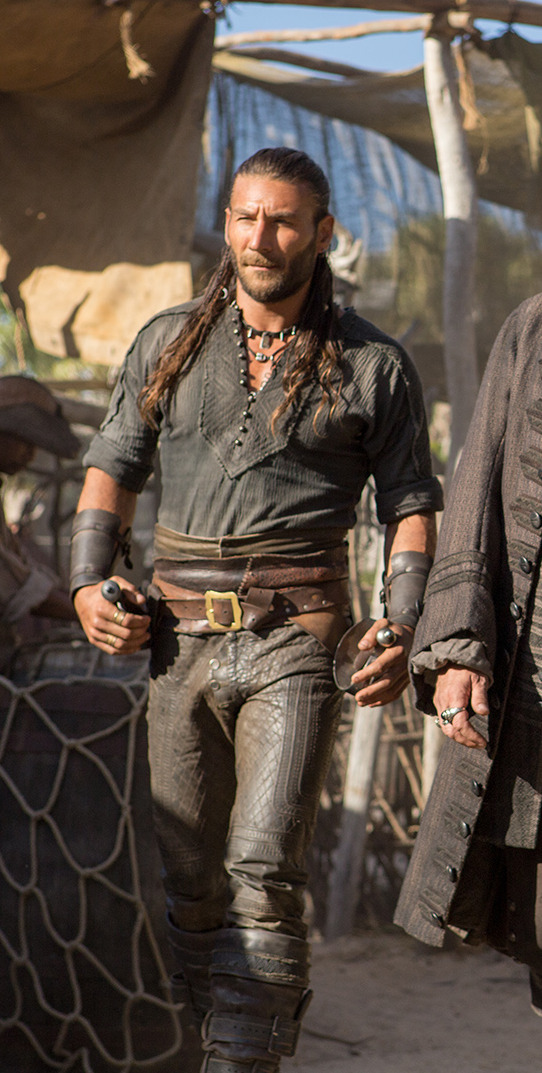
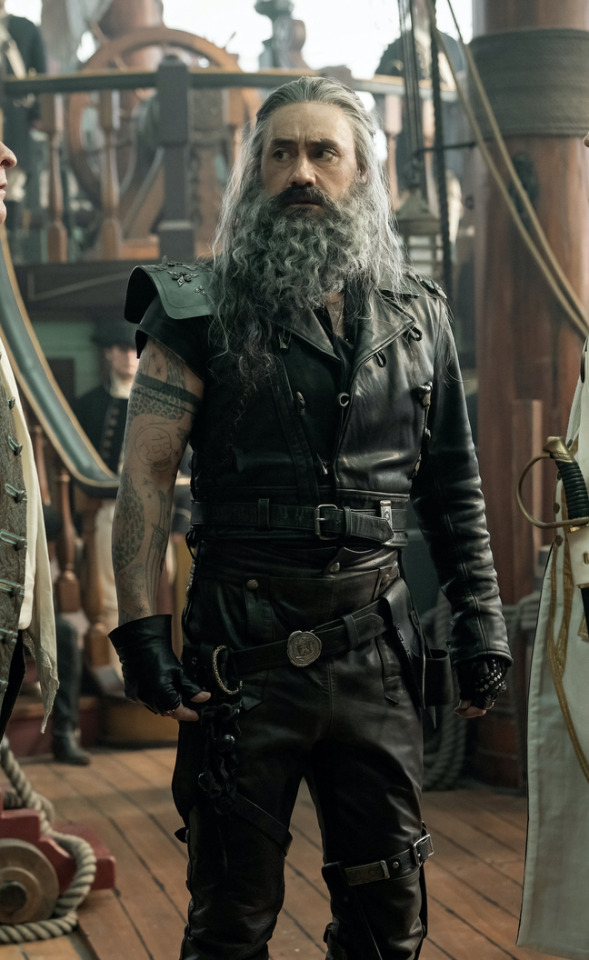
Here's the thing. Leather pants in period dramas isn't new. You've got your Vikings, Tudors, Outlander, Pirates of the Caribbean, Once Upon a Time, Will, The Musketeers, even Shakespeare in Love - they love to shove people in leather and call it a day. But where does this come from?

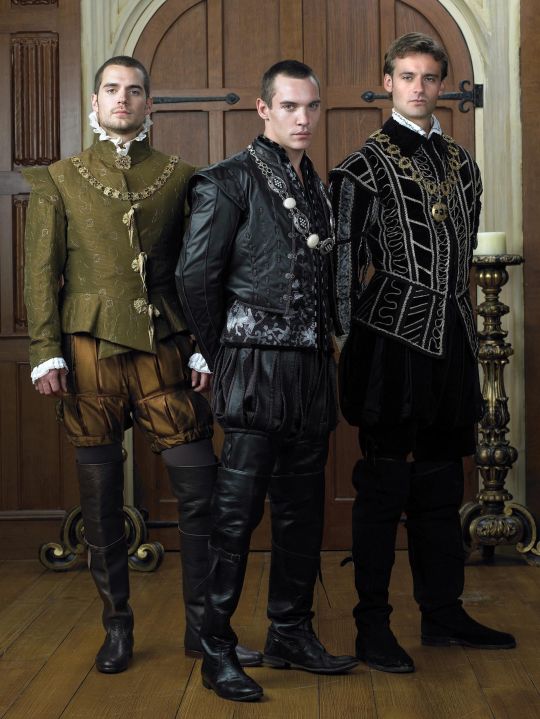
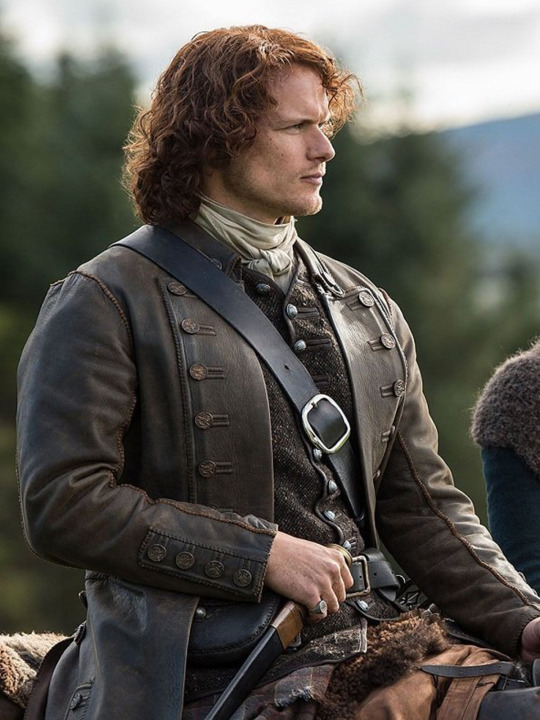

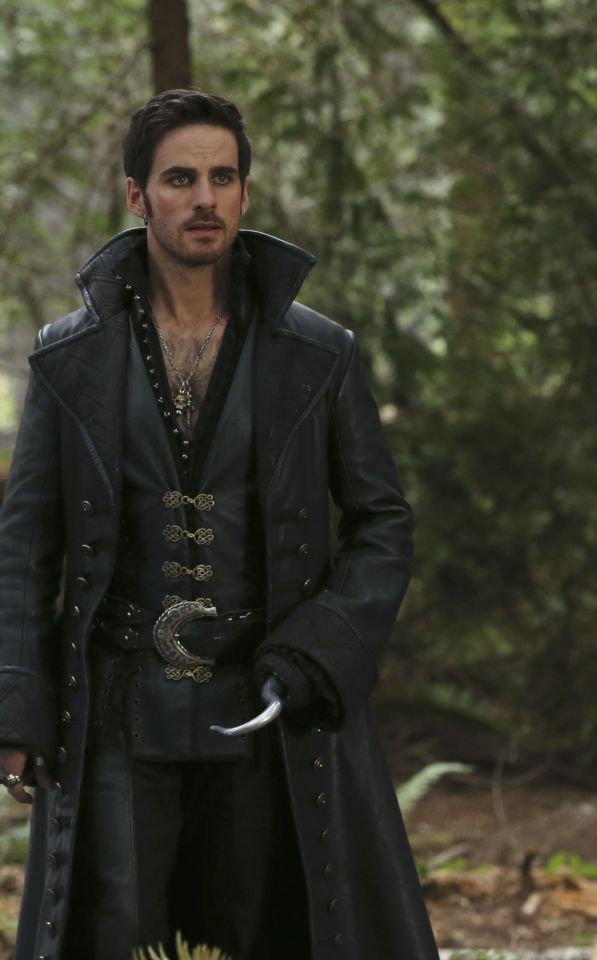
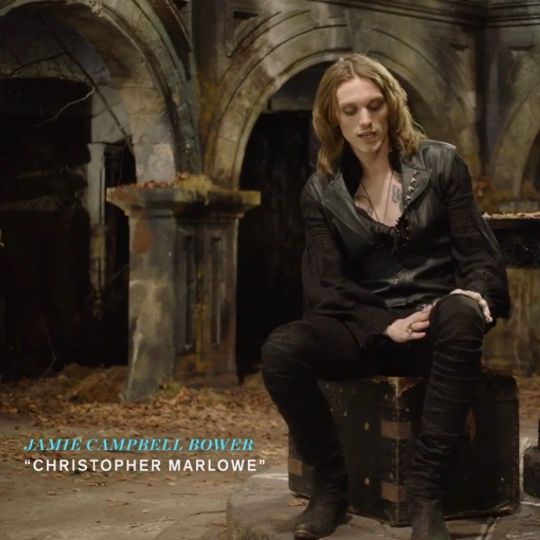
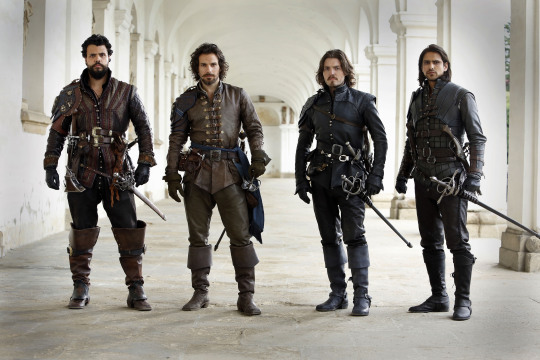

Obviously we have the modern connotations. Modern leather clothes developed in a few subcultures: cowboys drew on Native American clothing. (Allegedly. This is a little beyond my purview, I haven't seen any solid evidence, and it sounds like the kind of fact that people repeat a lot but is based on an assumption. I wouldn't know, though.) Leather was used in some WWI and II uniforms.
But the big boom came in the mid-C20th in motorcycle, punk/goth, and gay subcultures, all intertwined with each other and the above. Motorcyclists wear leather as practical protective gear, and it gets picked up by rock and punk artists as a symbol of counterculture, and transferred to movie designs. It gets wrapped up in gay and kink communities, with even more countercultural and taboo meanings. By the late C20th, leather has entered mainstream fashion, but it still carries those references to goths, punks, BDSM, and motorbike gangs, to James Dean, Marlon Brando, and Mick Jagger. This is whence we get our Spikes and Dave Listers in 1980s/90s media, bad boys and working-class punks.


And some of the above "historical" design choices clearly build on these meanings. William Shakespeare is dressed in a black leather doublet to evoke the swaggering bad boy artist heartthrob, probably down on his luck. So is Kit Marlowe.
But the associations get a little fuzzier after that. Hook, with his eyeliner and jewellery, sure. King Henry, yeah, I see it. It's hideously ahistorical, but sure. But what about Jamie and Will and Ragnar, in their browns and shabby, battle-ready chic? Well, here we get the other strain of Bad Period Drama Leather.
See, designers like to point to history, but it's just not true. Leather armour, especially in the western/European world, is very, very rare, and not just because it decays faster than metal. (Yes, even in ancient Greece/Rome, despite many articles claiming that as the start of the leather armour trend!) It simply wasn't used a lot, because it's frankly useless at defending the body compared to metal. Leather was used as a backing for some splint armour pieces, and for belts, sheathes, and buckles, but it simply wasn't worn like the costumes above. It's heavy, uncomfortable, and hard to repair - it's simply not practical for a garment when you have perfectly comfortable, insulating, and widely available linen, wool, and cotton!
As far as I can see, the real influence on leather in period dramas is fantasy. Fantasy media has proliferated the idea of leather armour as the lightweight choice for rangers, elves, and rogues, a natural, quiet, flexible material, less flashy or restrictive than metal. And it is cheaper for a costume department to make, and easier for an actor to wear on set. It's in Dungeons and Dragons and Lord of the Rings, King Arthur, Runescape, and World of Warcraft.

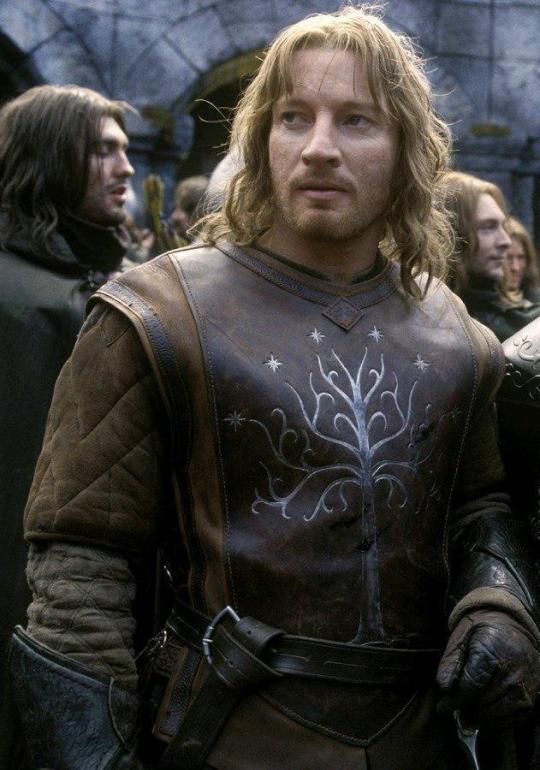
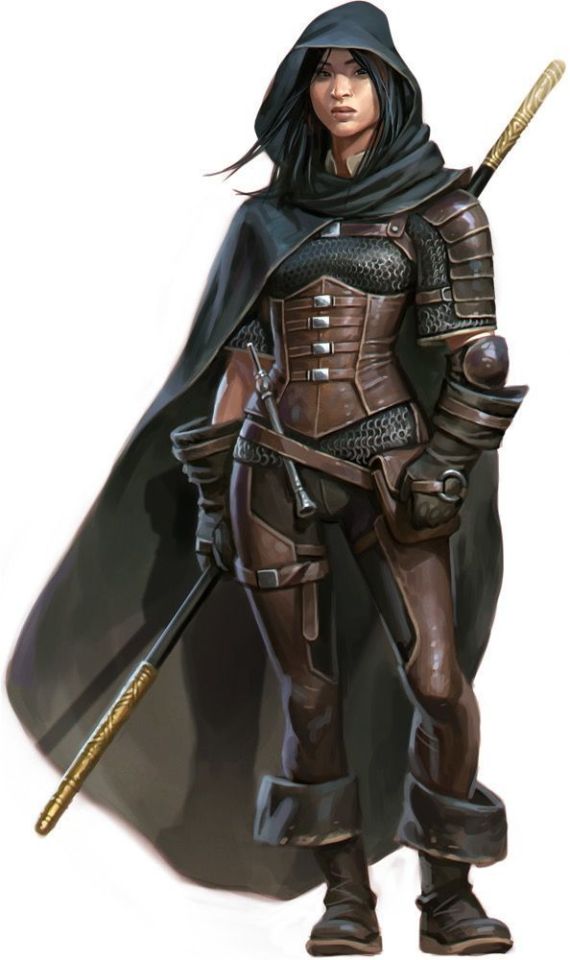
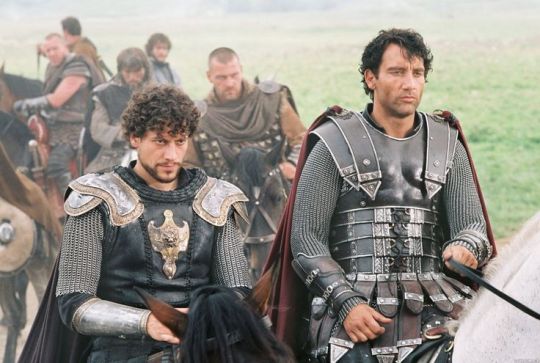

And I think this is how we get to characters like Ragnar and Vane. This idea of leather as practical gear and light armour, it's fantasy, but it has this lineage, behind which sits cowboy chaps and bomber/flight jackets. It's usually brown compared to the punk bad boy's black, less shiny, and more often piecemeal or decorated. In fact, there's a great distinction between the two Period Leather Modes within the same piece of media: Robin Hood (2006)! Compare the brooding, fascist-coded villain Guy of Gisborne with the shabby, bow-wielding, forest-dwelling Robin:

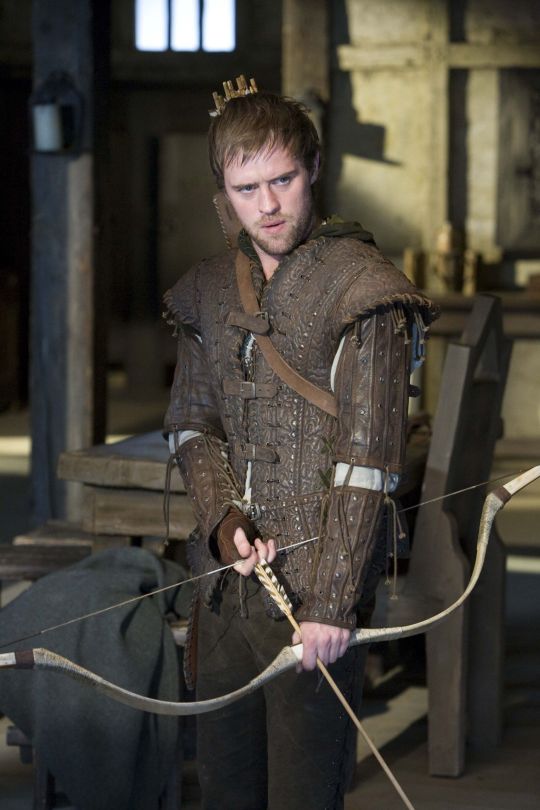
So, back to the original question: What's the difference between Charles Vane in Black Sails, and Edward Teach in Our Flag Means Death?
Simply put, it's intention. There is nothing intentional about Vane's leather in Black Sails. It's not the only leather in the show, and it only says what all shabby period leather says, relying on the same tropes as fantasy armour: he's a bad boy and a fighter in workaday leather, poor, flexible, and practical. None of these connotations are based in reality or history, and they've been done countless times before. It's boring design, neither historically accurate nor particularly creative, but much the same as all the other shabby chic fighters on our screens. He has a broad lineage in Lord of the Rings and Pirates of the Caribbean and such, but that's it.
In Our Flag, however, the lineage is much, much more intentional. Ed is a direct homage to Mad Max, the costuming in which is both practical (Max is an ex-cop and road warrior), and draws on punk and kink designs to evoke a counterculture gone mad to the point of social breakdown, exploiting the thrill of the taboo to frighten and titillate the audience.
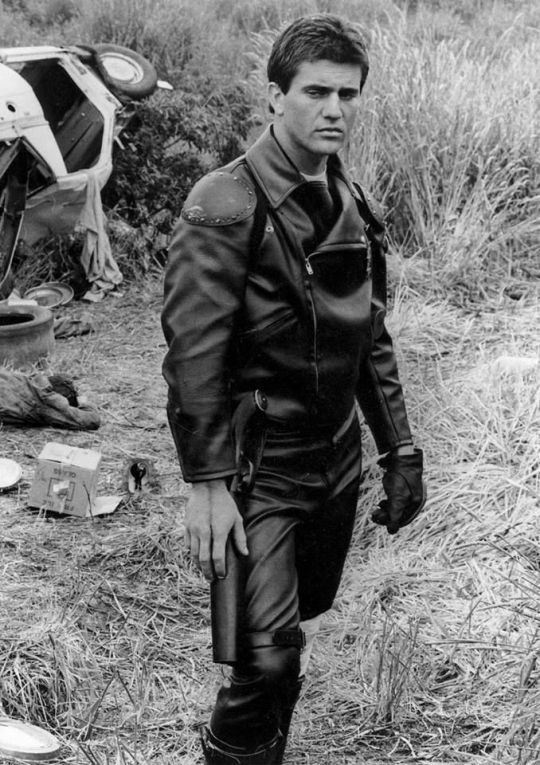
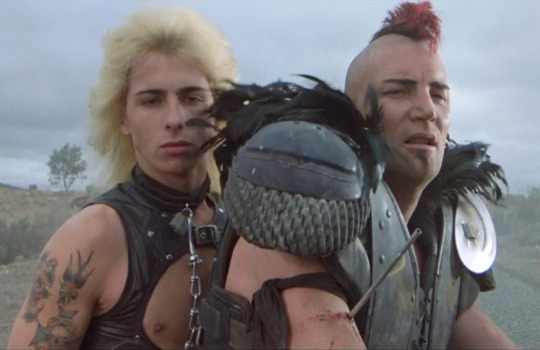
In particular, Ed is styled after Max in the second movie, having lost his family, been badly injured, and watched the world turn into an apocalypse. He's a broken man, withdrawn, violent, and deliberately cutting himself off from others to avoid getting hurt again. The plot of Mad Max 2 is him learning to open up and help others, making himself vulnerable to more loss, but more human in the process.

This ties directly into the themes of Our Flag - it's a deliberate intertext. Ed's emotional journey is also one from isolation and pain to vulnerability, community, and love. Mad Max (intentionally and unintentionally) explores themes of masculinity, violence, and power, while Max has become simplified in the popular imagination as a stoic, badass action hero rather than the more complex character he is, struggling with loss and humanity. Similarly, Our Flag explores masculinity, both textually (Stede is trying to build a less abusive pirate culture) and metatextually (the show champions complex, banal, and tender masculinities, especially when we're used to only seeing pirates in either gritty action movies or childish comedies).
Our Flag also draws on the specific countercultures of motorcycles, rockers, and gay/BDSM culture in its design and themes. Naturally, in such a queer show, one can't help but make the connection between leather pirates and leather daddies, and the design certainly nods at this, with its vests and studs. I always think about this guy, with his flat cap so reminiscient of gay leather fashions.

More overtly, though, Blackbeard and his crew are styled as both violent gangsters and countercultural rockstars. They rove the seas like a bikie gang, free and violent, and are seen as icons, bad boys and celebrities. Other pirates revere Blackbeard and wish they could be on his crew, while civilians are awed by his reputation, desperate for juicy, gory details.
This isn't all of why I like the costuming in Our Flag Means Death (especially season 1). Stede's outfits are by no means accurate, but they're a lot more accurate than most pirate media, and they're bright and colourful, with accurate and delightful silks, lace, velvets, and brocades, and lovely, puffy skirts on his jackets. Many of the Revenge crew wear recognisable sailor's trousers, and practical but bright, varied gear that easily conveys personality and flair. There is a surprising dedication to little details, like changing Ed's trousers to fall-fronts for a historical feel, Izzy's puffy sleeves, the handmade fringe on Lucius's red jacket, or the increasing absurdity of navy uniform cuffs between Nigel and Chauncey.
A really big one is the fact that they don't shy away from historical footwear! In almost every example above, we see the period drama's obsession with putting men in skinny jeans and bucket-top boots, but not only does Stede wear his little red-heeled shoes with stockings, but most of his crew, and the ordinary people of Barbados, wear low boots or pumps, and even rough, masculine characters like Pete wear knee breeches and bright colours. It's inaccurate, but at least it's a new kind of inaccuracy, that builds much more on actual historical fashions, and eschews the shortcuts of other, grittier period dramas in favour of colour and personality.
But also. At least it fucking says something with its leather.
#everyone say 'thank you togas' for not including a long tangent about evil rimmer in red dwarf 5x05#Our Flag Means Death#Togas does meta#and yes these principles DO fall apart slightly in s2 and i DON'T like those costumes as much#don't get me wrong they're fun and gorgeous - but generally a bit less deep and more inaccurate. so. :(#I'm not sure this really says anything new about Our Flag but I just needed to get my thoughts out#i hate hate hate Gritty Period Drama costumes they're so boring and so ugly and so wrong#god bless OFMD for using more than 3 muted colours and actually putting men in heels (and not as a shorthand for rich/foppish villainy) <3#looking at that Tudors still is insane like they really will go to any lengths to not make men feel like they've got bare legs XD#image descriptions in alt text#and yes i DID just sink about two hours into those so you'd better appreciate them
1K notes
·
View notes
Text
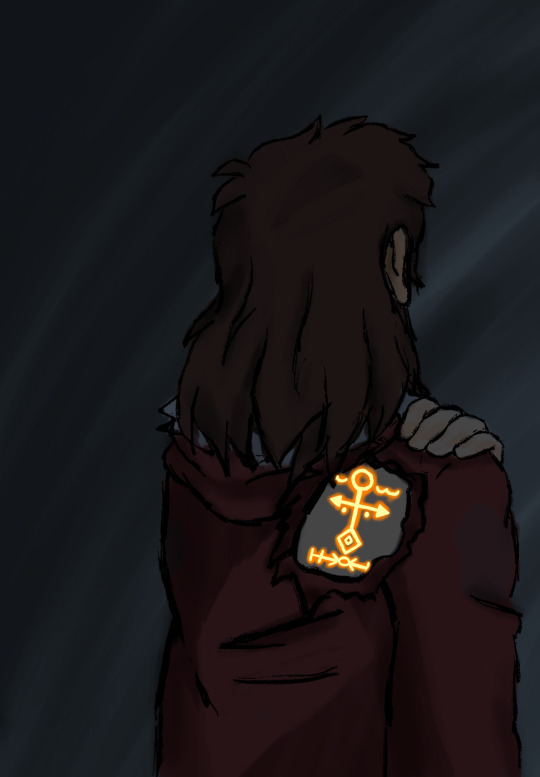

matching not-a-tattoo ideas for you and your twin!




so that mention of brands in the new book huh
#bill: thats right im a jerk#gravity falls#stanley pines#stan pines#stanford pines#ford pines#book of bill spoilers#sorta!#neno draws#thanks anistarrose for writing out the image descriptions!!#gf meta
991 notes
·
View notes
Text

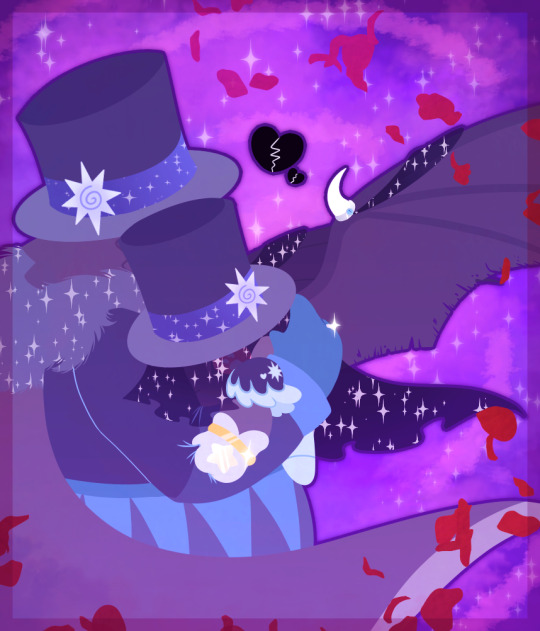
☀️ IT'S MY BIRTHDAY!! 🌙
This is my gift to myself :) I drew my favorite guys ever.
For a while I've been itching to draw the wedding outfits from this post again. I made them up on the fly as I was drawing, but I actually really like how they ended up turning out. They're super cute!! (though, yet again, you can't see almost any part of Dedede's outfit... 💔)
But then I couldn't get it out of my head to make a companion piece for it, with their mirror versions. And so. I did. What they have going on is a little bit messy, though...
Marriage or divorce!! Take your pick.
#kirby#kirby series#meta knight#king dedede#metadede#dark meta knight#shadow dedede#mirror metadede#i do like mirror mtdd. like a lot. but poor planning ahead with hcs and ocs caused them to end up. kind of doomed in my thing lol#maybe i'll go in depth about it one day. as much as i can anyway. i haven't fully figured it out myself#my art#couple details:#mk's tooth gaps are probably one of my favorite parts of his drawing. they're just so cute i'm so glad i knocked his teeth out#while mtdd is on Non Descript Happy Place mirror mtdd is specifically in the dimension mirror level from katam and ktd#just slightly. sparklier and shinier. because that's just how i do things. and without the buildings#i did try to add them but it made everything busier than it already was#mirror mtdd's faces are obscured on purpose but if you look closely you can catch a peek of dmk's expression through his veil#which! it's meant to be kind of like a widow's veil.. symbolism and what not#i couldn't think of what the opposite of a star was so i did hearts (for the plating. cheeks. and pauldrons)#i fucked up the rings.. because i got my lefts and rights confused..#but i kept it Anyway because it looked cool. i'm sorry though it's so annoying once you notice#i still have the flats and a better look at ddd's outfit (and a Little of sddd's face)#so maybe i'll post that later#i think that's about it#i'm 20 today :) sigh. the passage of time#god the way this has been crunched sickens me. don't look closer actually
188 notes
·
View notes
Text
i don't think the life series is "about" anything at all. it's not about survival or winning or player dynamics, or any theme. however i do think that the entire series - third life to present - is unified by a game design philosophy where all mechanics are engineered to disrupt the game as it has been played.
third life was initially pitched as "a[n ...] experiment" and its opening question was fundamentally how long can this last, which scar quickly proved was not long at all. it's easy to forget that it was not always a given that seasons would last approximately eight weeks and how the breakpoints of red/yellow violence would fall.
last life attempted to disrupt the established social norms by a) attempting to ban acting based on prior season's events and more importantly b) introducing social deduction mechanics which destabilized all alliances by default. similarly, although the ban on continuity never returned, double life's gimmick at its core is just another disruption of social dynamics. limited life iterates on last life's boogeyman dynamic while applying a different kind of time-limited pressure; secret and wild life are carousels of disruption to social play and "regular" or survival gameplay.
nevertheless players have defined the real rules of the game - the game-as-played which gives the series continuity - through their playing of it. both in spite of and because of the mechanical disruptions, conventions around sportsmanship and acceptable behavior are deeply entrenched. kills that are "illegal" by the written rules matter less than the player perception of them; the desire to invent social punishments for explicit infractions died with etho in the third life firing squad. players judge kill attempts as acceptable/impermissible by their relative status of reds vs. yellows, as the rudeness of ending someone's series early far outweighs the obvious strategic benefit of eliminating reds first. history persists, only as much as a given set of players negotiates it should. everyone should be along for the ride for as long as possible, but it will end.
ultimately life seasons are designed to make it difficult to play as you always have, and the players derive fun and drama from balancing their leaning into the gimmicks or into their habits. unfortunately this tension is deeply compelling and leads to wildly divergent opinions on what is "good" or "authentic" about a season or gimmick or episode because where the "good" tension is depends on the viewer, the point of view, the episode, etc.
#mc meta#this post is too long but whatever. now i can put this thought to rest#i just think we should acknowledge that third life is a gimmick series. it is#it's not a survival series or a death game it's an experiment. it says so in the description of at least etho's episodes.#i think the history & the conventions are very interesting! i think it's good to push against them bc that's good TV!#however. the consequences. and when something is novelty-first it then of course alienates anyone who prefers the old.
169 notes
·
View notes
Text
Mulch Products Winnipeg | Manitoba’s Concrete Products | Garden Items

#Mulch Products Winnipeg | Manitoba’s Concrete Products | Garden Items#Winnipeg | Winnipeg Business Supplies | Landscape and Aggregates In winnipeg#| Thrifty Winnipeg#Meta Description:#We are your one-stop shopping destination. The Canadian retail industry is#undergoing a revolution thanks to online shopping. Our store uses the latest#shopping technology to provide a unique shopping experience. Nearly everything#you buy from us is at the lowest possible#keywords:#Landscaping supply winnipeg#Decorative stones winnipeg#Granular Stone Winnipeg#Topsoil winnipeg
0 notes
Text
Let's talk about one of the ways Severus Snape created his imposing adult persona in – his walk and body movements.
Harry describes the walk of teen Snape like that: "Harry looked around and glimpsed Snape a short way away, moving between the tables toward the doors into the entrance hall, still absorbed in his own examination paper. Round-shouldered yet angular, he walked in a twitchy manner that recalled a spider, his oily hair swinging about his face."
- round-shouldered – I mean he is reading while walking, that nerd, but also kid Sev is described as standing "slightly hunched" on the 9¾ Platform, so I think it's safe to say he tended to hunch, maybe as a way to make himself smaller and less noticiable;
- walked in a twitchy, spidery maner – which implies certain nervousness and tension, clumsiness, jerky and antsy movements.
He also moves very quickly when there is danger and reacts like that's survival instinct:
Snape reacted so fast it was as though he had been expecting an attack: Dropping his bag, he plunged his hand inside his robes, and his wand was halfway into the air when James shouted, “Expelliarmus’
Disentangling himself from his robes, he got quickly to his feet, wand up, but Sirius said, “Petrificus Totalus!” and Snape keeled over again at once, rigid as a board.
To put it shortly, teen Severus is awkward, twitchy, constantly feeling unsafe and alert, and is immersed into his own world.
Now adult Snape is different. He is never described as hunched in the books – even when he lowers himself to look at something, he always "bends over", not "hunches over", we also have "Snape straightened up slowly and turned to look at her" after he bends over Dean's cauldron, so that was one thing to deal with.
We know he has a recognisable "prowling" walk, even when he's in a hurry:
"A hooded figure came swiftly down the front steps of the castle. Clearly not wanting to be seen, it walked as fast as possible toward the forbidden forest. Harry’s victory faded from his mind as he watched. He recognized the figure’s prowling walk. Snape, sneaking into the forest while everyone else was at dinner — what was going on?"
Severus is described as prowling on other occasions:
Snape prowled through the fumes, making waspish remarks about the Gryffindors’ work while the Slytherins sniggered appreciatively.
They sat and made notes on werewolves from the textbook, while Snape prowled up and down the rows of desks, examining the work they had been doing with Professor Lupin.
Snape hissed, letting go of his arm as though angry with himself. ‘I have as much right to prowl this school after dark as you do!" (he says it himself, so he does that shit deliberately, the fucker)
The most often used description of Snape's walk is "to sweep" forming different phrasal verbs, tho. It's mentioned at least 15 times through the books, there are some of them:
He swept around in his long black cloak, watching them weigh dried nettles and crush snake fangs, criticizing almost everyone...
Snape swept past Harry, making no comment about Hermione’s empty seat and cauldron.
Snape smirked as he swept off around the dungeon, fortunately not spotting Seamus Finnigan...
Snape nodded silently and swept out of the room.
he watched, with a trace of apprehension on his face, as Snape swept wordlessly after Sirius.
“I have awarded you the grades you would have received if you presented this work in your O.W.L,” said Snape with a smirk, as he swept among them, passing back their homework.
Snape strode to his office door, his wand still held at the ready, and swept out of sight.
Which sounds like a continuous, graceful, dramatic movement, as opposed to his hurried teen jerkiness. It's fluent in a way, almost gliding or slithering, if you will. Rather quick than slow, but in a controlled manner.
He also has his famous billowing cloak:
Snape bowed and set off back up the path, his black cloak billowing behind him.
Snape snarled, and he brushed past them, his long black cloak billowing out behind him.
said Harry, who was watching Snape running up the marble staircase in his mind’s eye, his black robes billowing behind him as ever...
There, his black robes rippling in a cold breeze, stood Severus Snape.
It was Snape. He approached Harry at a swift walk, his black robes swishing.
Snape whirled about, robes swishing behind him, and stormed out of the ward.
etc etc.
Sometimes he walks quickly for practicality:
Clearly not wanting to be seen, it walked as fast as possible toward the forbidden forest.
It sounded like Fudge and Snape. They were walking quickly along the corridor at the foot of the staircase.
Snape climbed up the stairs quickly and stopped beside Filch.
And sometimes slowly for dramatic effect:
Snape advanced on Ron slowly, and the room held its breath.
For a moment, nobody moved or said anything. Then Snape slowly lowered his hands.
Hardly daring to breathe, Harry remained crouched down as Snape emerged slowly from the classroom. His expression unfathomable, he returned to the party.
So I believe adult Snape usually walks kinda like he speaks, which is another learnt behaviour of his – softly, with deliberate menacing undertones, elegance, and precision.
Also we, of course, have a prominent occasion on which he outran a Hippogriff, and don't you people forget that. This man's got the range.
#this is not a definitive analysis or something so I surely forgot some descriptions#but I think it puts it together quite well#also it doesn't include his stims because there is a separate post for that:)#severus snape#pro severus snape#severus snape meta#pro snape#snape meta#snapedom
72 notes
·
View notes
Text


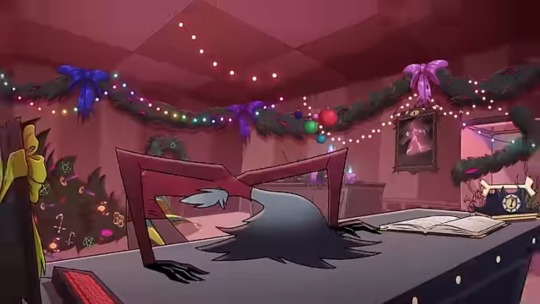
When Stolas is really, really upset, he occasionally stims by hitting his head. By Mr. Butler's complete lack of reaction, this must have been a fairly common occurrence in his early childhood.
I like that we see both happy and unhappy stims from him. The repetition feels deliberate, just like how both times see him super excited and anticipatory he does little hops or bounces (hard to tell which without seeing his feet).
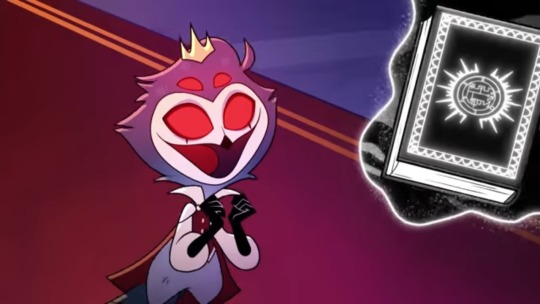

Another repeated stim is that when he's happy he tends to hold his fists up by his chest, which you can see in the scenes where he's bouncing too. In Seeing Stars he even shakes his fists because he's so excited to have found red glasses that look like his second pair of eyes (he's so fucking cute, I can't stand it).
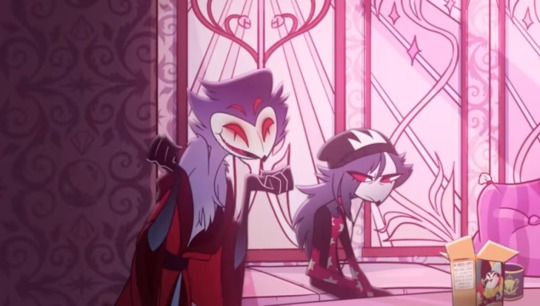


I wonder if we will see these same stims more often, now that his mask is off again and he's no longer being told he needs to hide his emotions.
#helluva boss#stolas goetia#text post#meta#my post#autistic stolas#yeah he's not beating the autism allegations#i am an autistic stolas truther through and through#image descriptions in alt text
502 notes
·
View notes
Text
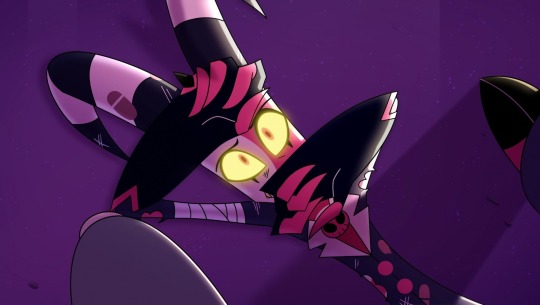
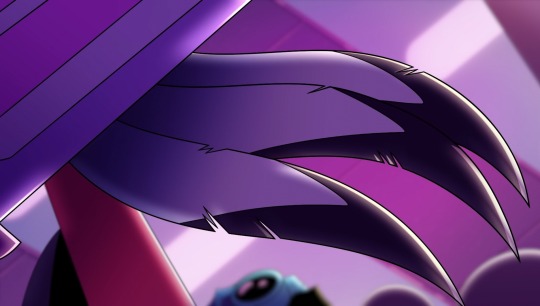
Never forget that in this moment we don't just hear the first note of Stolas Speaks (Stolas' theme song). We also hear the click of a camera as it takes a photograph.
And, sure, this makes sense, because dozens of reporters are documenting this moment, and more clicks can be heard moments later as Stolas is taken into the hospital.
But the reason we hear a click right at the same time as Blitz sees Stolas' feathers is the same reason time suddenly slows down for a split second. It's because this moment, this instant of realisation, is etching itself in Blitz's mind, and he will never forget it.
It's the moment he realises he's failed Stolas.
He's failed to show up. Failed to protect him. Failed to be there when Stolas needed him.
Just the same way he failed Fizz, and his mom, and Barbie. All moments that have haunted him for 15 years. Their photo going up in flames in his mind, over and over again every time he remembers the accident. And now this photo, too, will be tangible proof in his mind that he is doomed, that he is tainted. That he can't stop failing the ones he loves. That he will always make things worse.
He will never forgive himself for failing Stolas. It will never not haunt him a little bit. And, hopefully, he will never, ever let it happen again.
#helluva boss#Stolitz#western energy#blitz helluva boss#helluva boss blitz#helluva blitzo#blitzø#blitzo#helluva boss meta#image description in alt
1K notes
·
View notes